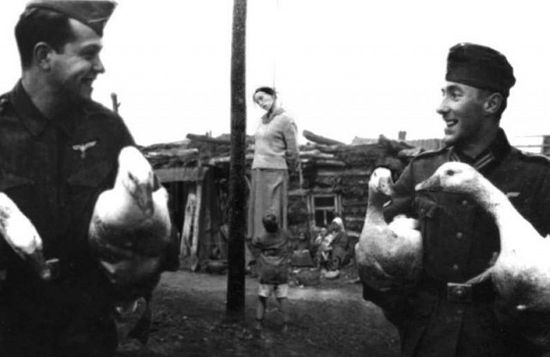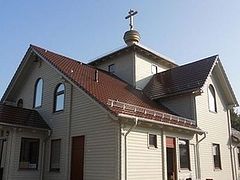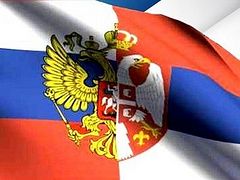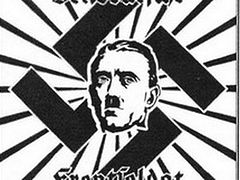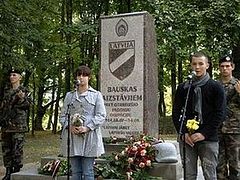It is of the utmost importance to remember the terrible Second World War and how it began. Especially when watching television or reading the mainstream news we must always be aware of the fact that a country’s leaders in our times have to justify the invasion and exploitation of other nations to their basically humane citizenry, gradually forming a strong picture of “the enemy” in peoples’ minds. All too often, people learn about these propaganda efforts only after millions have died in ruthless wars.
On this anniversary of Germany’s invasion of Soviet territory we present this paper by Professor Mikhail Ivanovich Frolov (November 2, 1924 – October 11, 2016), Doctor of History and Vice-President of the Academy of Military and Historical Sciences, Russian Federation
On June 22, 1941, Germany made a treacherous attack on the Soviet Union. It launched Operation Barbarossa: a blitzkrieg (“a lightning war”) against the USSR, which, according to the military-political leaders, was meant to crush the Soviet Union within eight to ten weeks. In unleashing their war against the USSR, the Hitlerites claimed that the Red Army was allegedly preparing to attack Europe in 1941, that Germany faced a threat and thus had to begin a preventive war against the Soviet Union in order to defend itself and other countries of Western Europe. Hitler first explained the war as a preventative measure to the Wehrmacht generals on the day of the offensive against our country. He said that, “the moment has come when a wait-and-see policy is not only a sin but also a crime against the interests of the German people, and, therefore, of all Europe. At present around 150 Russian divisions are standing at our border. For several weeks this border has been continuously violated, and not only on our territory, but also in far north of Europe and in Romania. Soviet pilots amused themselves by ignoring our border, perhaps to prove to us that they already consider themselves the masters of these territories. On the night of June 17 to 18 Russian patrols again made an incursion onto the German territory and were driven back only following a lengthy exchange of fire.”1 Hitler repeated the same in his appeal to the Eastern Front soldiers that he read out on the night of June 21 to 22, 1941, before the Wehrmacht personnel. In it military operations against the Soviet Union were justified by “the Russian aggressive intentions”.2
This version was officially voiced on June 22, 1941, in a statement of a German ambassador Friedrich Schulenburg, conveyed to the Soviet Government, and in a memorandum that was handed over on the same day by Joachim Ribbentrop to the Soviet Ambassador in Berlin Vladimir Dekanozov—already after the German troops’ invasion of the Soviet territory. Schulenburg stated that while Germany most faithfully abode by the Soviet-German Non-Aggression Pact, Russia violated it more than once. The USSR was accused of “sabotage, terrorism and espionage activities” against Germany and “the opposition to Germany’s attempts to achieve lasting stability in Europe.”
The Soviet Union allegedly colluded with Britain “in order to attack the German troops in Romania and Bulgaria,” concentrating “all of Russia’s Armed Forces along the frontline between the Baltic and the Black Seas”; the USSR “poses a threat to the Reich”. This is why the Führer ordered the German Armed Forces to repel this threat with all their might.”3 The German Government’s memorandum that was handed over to Dekanozov read: “The Soviet Government’s aggressive actions towards Germany, coupled with a serious danger caused by the movement of the Soviet troops to our eastern border, impel the Reich to undertake retaliatory actions.”4 Hitler’s address to the German people, read out by Goebbels over the radio on the morning of June 22, contained the accusations of Soviet aggression, of plans “to undermine Germany from within”.5
Thus, the Nazi leaders, trying to justify the Fascist aggression, asserted that they had to resort to a “preventive” war against the USSR because it allegedly was preparing to attack Germany and to make “a stab in the back”. The version of the “preventive strike” aimed to relieve German Fascism of responsibility for unleashing the war, to prove that the USSR was guilty of the beginning of World War II, for it follows from this that the Wehrmacht took the offensive only in a military sense and was justified politically. In a wider sense, some Russian historians argue that it also concerns the problem of Nazi Germany’s responsibility for the Second World War.6
In the Soviet Government’s statement in connection with the German invasion of the USSR these “arguments in support of” the Fascist aggression were qualified as a policy of “stirring up accusations post factum about Soviet violations of the Soviet-German Non-Aggression Pact”.7
Russian historians, revealing the sources of the version of “the preventive war”, emphasize that this point of view (“the war of Germany against the USSR is just a prevention of the Red Army’s first strike”) was expressed by other leaders of the Third Reich from Hitler’s inner circle as well; among them were Rudolf Hess, Heydrich, Colonel General A. Jodl and others. These allegations were adopted by the Propaganda Agency of Goebbels and were used for a long time to brainwash the German people and the populations of other countries; the idea of “preventive war” was steadily inculcated into people’s minds. Under the influence of this and pre-war propaganda, many Germans—at the front and at the rear alike—believed that the war was just, as indicated in the Security Service’s report of July 7, 1941,8 and deemed it “an absolutely necessary defensive warfare”.9
The Russian historians who reject the Hitlerites’ fabrications also rely on the fact that the version of the preventive attack—the most convenient version for justifying the aggression—was rejected by none other than Hitler himself. At a conference on July 21, 1941, Hitler, characterizing Stalin’s intentions, stated that “there are no signs of a Soviet attack against us”.10 It should be stressed that at that very conference, Hitler ordered Field Marshal W. Brauchitsch to develop the plan of invasion of the USSR.
Let us mention one more very important statement by Hitler in which he concisely characterized the underlying motives behind his decision to declare war on the USSR, which is quoted in a work by the German historian Dr. Joachim Tauber. On February 15, 1945 (towards the end of the war), Hitler returned to the theme of war. He said: “During the war I had no more difficult decision to make than to give the order to attack Russia. There was no more hope to end the war in the West by landing on the British Isles. The war could have lasted forever; and the likelihood of America’s involvement in the war ever increased… Time—and again time—was against us! The only way to convince Britain to sign a peace treaty was to crush the Red Army—thus Britain would have lost any hope to oppose us by an equally strong enemy on the continent.”11
Let us note that not a word was said about the threat of the Soviet Union’s attack on Germany, about “a stab in the back”, and other arguments supporting and justifying “a preventive” invasion of the USSR.
And let us read carefully the notes of the Third Reich Minister of Propaganda J. Goebbels. On June 16, 1941, he wrote down in his diary, “The Führer says that we must score a victory, no matter whether we are right or not. We’ve got to win a victory at any price, otherwise the German nation will be wiped off the face of the earth.”12 On July 9, in his euphoria after the victories of the Wehrmacht, he wrote, “A preventive war is the most reliable and convenient kind of war, if we take into account that the enemy is to be attacked at the first available opportunity anyway. This is precisely what has been applied to Bolshevism. We will beat it until it is completely destroyed.”13 As the saying goes—no comment.
The version of “preventive” war was rejected at the Nuremberg Trials of the major war criminals before the International Military Tribunal in 1945 to 1946. Thus, Hans Fritzsche who had headed the German Press Section and Radio Broadcasting, said (when he was giving evidence) that he had organized a large-scale campaign of anti-Soviet propaganda, striving to convince the public that “we only forestalled the Soviet Union’s military assault… The next task of the German propaganda was to highlight all the time that the Soviet Union, not Germany, was responsible for this war, though there were no grounds for accusing the USSR of the preparations to attack Germany.”14 Moreover, a number of German generals who gave evidence during the Trial did not deny this. Even the main developer of the plan of Operation Barbarossa Friedrich Paulus admitted that “we found no facts which bore witness to the Soviet Union’s preparations for an attack.” And General and Field Marshall von Rundstedt said, “In March 1941 I did not have the slightest idea of any alleged Soviet military preparations.” He and other generals at a briefing with Hitler were astonished when they heard that “the Russians are arming themselves to the teeth and now deploying their troops in order to attack us.” According to General von Brauchitsch, when he was visiting the Seventeenth Army in June 1941, he received clear evidence that the Red Army forces had a purely defensive character. 15
“On June 22, 1941, without a declaration of war, Germany invaded Soviet territory in accordance with prearranged plans. The evidence presented to the tribunal testify to the fact that Germany had had elaborate plans to crush the USSR as a political and military power in order to ‘blaze a trail’ to the East according to its aspirations… Plans for economic exploitation of the USSR, mass displacement of the population, the murder of commissars and political leaders was part of an elaborate design, the implementation of which was begun on June 22 without any warning or any lawful basis for doing so. It was stark aggression.”16
Hitler’s Reich every time officially explained its actions by this thesis that the attack on the USSR was preventive, as G. Kumanev and E. Shklyar rightly note. The plan to invade Austria was devised four months before the Anschluss, the plan to invade Czechoslovakia—and eleven months before its occupation, the invasion of Poland—was devised five months before the beginning of the warfare, and the invasion of the Soviet Union was devised almost a year before the attack. It should also be taken into account that the above countries were ready to compromise and to make concessions in order to avoid German aggression.17
The version of a “preventive” war is absolutely untenable; Nazi Germany committed an unprovoked treacherous attack. In the view of A. Utkin, “all in all, leading historiographers agree that what began in June of 1941 was not a preventive war but the implementation of Hitler’s real objectives, which were ideologically motivated.”18
The untenability of the Nazi thesis of “preventive” war was quite thoroughly proved in many works by Russian historians. The facts that they cited, based on archival and other sources, indicate that the Soviet Union did not plan any aggressive actions and did not intend to attack anybody. Most Russian authors provide firm evidence that the thesis of Germany’s “preventive” war against the Soviet Union aimed to misrepresent the social and political nature of a war by Soviet people against Nazi Germany, denying its true nature of a just and liberating war. They rely on well-known documents which irrefutably testify to the barbarous and ruthless nature of the war of Germany against the USSR, which can be characterized by two words: to conquer and to destroy.
Here is how Hitler defined the military and political aims of the war against the USSR as early as March 1941: “Our chief mission in Russia is to smash the Armed Forces, to destroy the state… I mean fighting until the enemy is completely destroyed.” Here is what was implied by these words: “To destroy Russia’s vital forces. No political institution that could be restored should be left.”19 Chief of General Staff of German Land Forces Colonel General F. Galder wrote down Hitler’s directions in his diary: “Unless we succeed in this, in some thirty years we will be opposed by the same Communist enemy even if we crush it now. We are warring not for the preservation of the enemy.” 20 In connection with this Hitler’s war, directives ran that the war against Russia was to be waged “with unheard-of cruelty”. The instruction in military training for troops reads: “Remember the glory and the victory of Germany. You must kill exactly 100 Russians for your personal fame. You have neither a heart nor nerves—you don’t need them at war. Having killed pity and compassion inside yourself, you shall murder any Russian; don’t stop, evenit’s an old man, or a woman, a girl or a boy is standing in front of you. Murder! In this way you will save yourself from death, ensure the future of your family and win fame forever.”21 V.R. Medinsky emphasizes that the instructions manual for soldiers commanded them to kill not commissars (there was a separate procedure applied to political workers), but all Russian people. This manual was intended not for SS [Nazi Special Police Force] cut-throats or officers of some punitive squads. It was designed for use by ordinary soldiers.22
This demand for cruelty to the population runs through the orders of German commanders. Thus, Colonel General Erich Hoepner demanded: “The war against Russia… It is a centuries-old struggle of the Germans against the Slavs, the defense of European culture from the Moscow-Asian plague, the repulse of Bolshevism. This struggle should be aimed at turning today’s Russia into ruins, and therefore it should be conducted with unheard-of cruelty.”23
In 1991 the exhibition, “A War of Annihilation: the Wehrmacht’s Crimes in 1941-1944”, was shown to a mass audience in FRG. It was a documentary exhibition. It demonstrated that a war of annihilation was made on the basis of such orders against the USSR. The exhibition catalogue is testimony to the fact that the Wehrmacht was responsible for waging war in the East in 1941 to 1944, “which contradicted international law”, for slaughtering millions of people. 24
The order by Hitler as Supreme Commander of the Wehrmacht, dated May 13, 1941, and entitled The Exercise of Martial Jurisdiction in the War with the Soviet Union, reads. “With respect to offences committed against enemy civilians by members or employees of the Wehrmacht, prosecution is not obligatory, even if the act is nevertheless a military crime or offence.”25 In the view of the German historian Jürgen Förster, this order legalized draconian punishment of the Soviet population, in essence regarding the anti-Soviet war as a conflict absolutely different from all earlier “military campaigns” of 1939. He wrote that this war should be considered “a struggle of the Germans against the Slavs” with intention of “destroying modern Russia”. 26
Clarifying his long-term plans, Hitler said, “It must be absolutely clear that we will never leave these lands [the invaded territories—M.F.].” According to the Führer, these lands were the great prize which he needed to assimilate. Three criteria were established for every occupied country: firstly, to capture; secondly, to govern; and, thirdly, to exploit. In order to succeed in this objective, “we will take all necessary measures: execution by a firing squad, displacement and so on.”27 He was concise: “We don’t need any Russia: neither imperial nor Soviet Russia.”
And what was supposed to happen with Russians and other peoples of the country? Let us refer to the Generalplan Ost and the documents related to it. The plan itself was found in the Federal Archive of Germany only in the late 1980s and it was not digitized until December 2009.28 The document was put forward by Dr. Wetzel from Rosenberg’s Ministry for the Occupied Eastern Territories, dated April 1942. It reads, “It is not about crushing the state with the center in Moscow. Most likely the ultimate goal is to destroy the Russians as a nation… from the biological, or, rather, the racial and biological point of view…” 29 Now let us quote another extract from the documents which became known: “The elimination of the biological force of Eastern peoples by means of negative demographic policy… Its aim is (in the long term) to alter the ratio of foreign peoples to the Germans in favor of the Germans in order to minimize the difficulties that might arise due to our domination over them.”30 Hitler believed that there was no point in sparing the lives of subhumans. “This year, twenty to thirty million people in Russia will die of starvation. Perhaps that is even better—after all, we need to reduce some people’s populations,” Göring said during a conversation with Ciano in November 1941, repeating Hitler’s thoughts.31 In his opinion, at most fifteen to thirty million people were to remain on the territory of Russia. All the rest were either to migrate to the East or to die—“as they please.”32 Assessing the objects of the German political echelon, the German historian O. Klöde wrote that, “not only Bolshevism but the whole Russian nation were destined to be destroyed… As for the Slavs, Hitler wanted not only to exterminate the ‘alien’ worldview, but also to exterminate the ‘foreign’ people.”33
An unenviable fate awaited all who would survive. During one of his table talks Hitler said, “First of all, the subjugated peoples must serve the interests of our economy. The Slavs are made for working for us, Germans, and for nothing else. Our aim is to settle 100 million Germans to current places of their residence. The German authorities should reside in best possible buildings and governors will dwell in palaces. Within a radius of thirty to forty kilometers (c. 18.6 to c. 24.8 miles) around the principal cities of provinces there will be green belts with beautiful German-style villages, interconnected by centers and good roads. And there will be absolutely another world beyond these belts. Let Russians live there like they used to. We will only take over their best lands. Let these aborigines-Slavs mess about in their bogs… We should restrict them from most activities. No printing should be allowed! No compulsory schooling!...”34
The Nazis planned to create three Reichskommissariats on the territory of the USSR—German provinces, and to wipe Moscow, Leningrad, Kiev and a number of other cities off the face of the earth. In the War Directory—one of the most detailed documents that sets forth the plan of exploitation of the USSR territory—the aim of turning of the Soviet Union into a sort of a German colony was explicitly formulated. There was a strong accent on the starvation of most of Russia’s population throughout the document. 35
Defeat of the Soviet Union was seen as a major prerequisite for establishing German hegemony over the whole European continent and as a starting point for gaining global domination. As the German historian Andreas Hillgruber notes: “The German eastward expansion was crucial in the Nazi military concept”; after the successful “eastern war” they hoped to have carte blanche to “implement their strategic program for world domination.”36
This is how the famous German historian Hans-Adolf Jacobsen characterized Hitler’s designs: “He (Hitler) firmly decided to dismember Russia, to mercilessly exploit and despotically oppress ‘the Eastern untermenchen’, and to use the country for the ‘great German race’.”37 After the invasion of the Soviet territory and occupation of a number of regions the Nazis proceeded to execute of the program of genocide of “the race of untermenchen”—the Russian nation. 38
 "Here German brutes burned 35 houses and murdered 22 villagers. Soldier, get revenge on the Fascist monsters."
"Here German brutes burned 35 houses and murdered 22 villagers. Soldier, get revenge on the Fascist monsters." In view of the aforesaid, the main objectives of the German political and military leaders in the anti-Soviet war become very clear. They demonstrate the groundlessness of allegations of a “war between Hitler and Stalin”, “between National Socialism and European Bolshevism” which were drummed into the Germans’ heads by Goebbels and his henchmen and which are supported by some in today’s Russia. The victory of Nazi Germany would have resulted not in a crushing defeat of totalitarian rule (as some neo-liberal historians argue), but to the dismemberment of the country, the extermination of tens of millions of people, and enslavement of all the rest by German colonists. 39
Well-informed readers may ask: Was there any point in exposing the plans of Nazi Germany in the anti-Russian war in detail and in the quoting documentary sources, if all this information is well known to the overwhelming majority of people who love their nation and fatherland? I think it was worthwhile because this aspect of the war—the most essential one, which determines its character—has nearly disappeared from TV and radio programs over the past years; the barbarous plans of Fascists are barely mentioned in modern books on the Great Patriotic War [the Russian term for World War II.—Ed.] along with some textbooks. According to M. Demurin, Ambassador Extraordinary and Plenipotentiary II class, the most important specificity of the Great Patriotic War, “that Russian people fought not for their fame, but for their life,”40 is today being omitted by many school textbooks as “irrelevant”. The disintegration of the USSR gave freedom to certain forces that are interested in reconsidering the causes and the course of the Great Patriotic War. And today, seventy years after our victory over Germany [the article was written in 2015—Ed.], it is necessary to expose the objectives and plans of Nazi Germany for the USSR and its people along with the far-reaching designs of German Fascism. They rule out any idea that Hitler allegedly waged a “preventive” war. Not only the destiny of the Soviet people, but the destinies of all the peoples of the world depended on the outcome of the struggle of the USSR with Nazi Germany.
For the Soviet Union the war had quite a different nature. For its peoples, the struggle against Germany and its allies became the Great Patriotic War for the state’s national independence, for the freedom and honor of the motherland. In this war the Soviet people strove to help the peoples of other countries free themselves from Hitler’s yoke, and save dying civilization from Fascist barbarity.
Any attempts to revise and rewrite the past (conscious or unconscious), to misrepresent and distort the events and facts related to the Great Patriotic War are hopeless and have no prospects regardless of how closely they echo one or another political milieu.
Beyond a doubt, the falsifiers’ revisionist positions should not be underestimated. We must vigorously oppose these misrepresentations of the real nature of the Great Patriotic War. It is vital to oppose the widespread and ever more common false ideas about the war with the historical truth, founded on documentary sources, and reveal the victories of Soviet forces in the epic battles on the Eastern Front.




